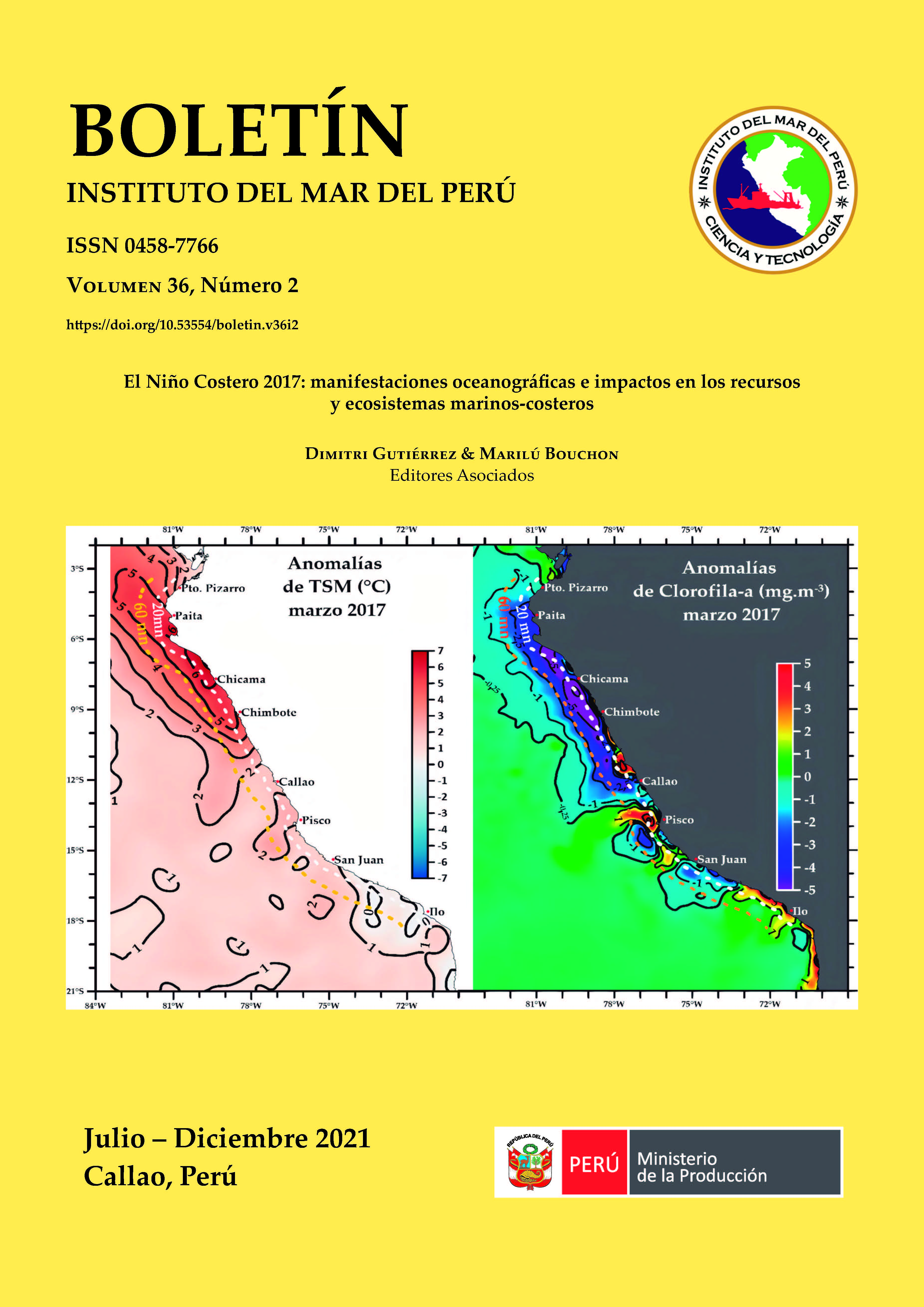Assessment of economic loss caused by the illegal extraction of seeds of Peruvian scallop Argopecten purpuratus in Independencia Bay (14°15’S) during the 2015-2017 warm period
DOI:
https://doi.org/10.53554/boletin.v36i2.351Abstract
The SST in Independencia Bay (14°15’S), between 2015 and 2017, was characterized by positive thermal anomalies, which peaked at +3.0 °C in January 2016. This condition favored the population growth of Peruvian scallop (Argopecten purpuratus) in its natural banks. Although it is an illegal activity, the availability of their seeds generated expectations for their extraction. given the significant demand for seeds to be used in enclosures, within and outside the bay. A total of 3.32 t, with a mean height of 22.4 mm, was landed in Laguna Grande in March 2016, then landings increased to 20.77 t in June of the same year. By the end of the year, the total amount was 59.665 t. The availability of seeds was low in 2017, with landings in September amounting to 0.13 tons; practically all the natural banks were exhausted. We estimated, based on landings and individual weights, an extraction of 19,691 million seeds, which generated a marketing value of 1,026 million soles (about US$ 309 million in that time). Their projected sizes at 12 months (K = 0.5 year-1, L∞ = 118 mm, t0 = 0), when the scallops reach their commercial size, would correspond to a value of 9.846 million soles (about US$ 2,857 million in that time). This estimation allows us to determine an economic loss higher than 8 million soles, in addition to the population loss of the resource caused by this illegal activity, since warm conditions favor the frequency of the reproductive activity (repeated spawning events) that supply new cohorts to the population. Thus, the illegal extraction of scallops’ seeds affected the yields of the natural banks of Independencia Bay during the 2017 coastal El Niño, impacting the species natural cycle.
Downloads
Alternative Metrics
Metrics
References
Argüelles J, Aguilar S, Alfaro S, Berrú P, De la Cruz J, Donayre S, Flores D, Galindo O, Hostia P, Ramírez A, Taipe A, Tejada A, Sanjinez M, Torres E, Ordinola E, Yamashiro C. 2011. Protocolo para la evaluación de concha de abanico Argopecten purpuratus (L.). Inf Inst Mar Perú. 38(4): 359-371.
Arntz W E. 1984. El Niño and Peru: Positive aspects. Oceanus. 27(2): 36-39.
Arntz W, Fahrbach E. 1996. El Niño Klimaexperiment der Natur. Berlin, Birkhäuser Verlag.
Estrella C, Guevara R. 1998. Informe estadístico anual de los recursos hidrobiológicos de la pesca artesanal por especies, artes, caletas y meses durante 1997. Inf Inst Mar Perú. 132: 420.
Flores M, Vera S, Padilla M, Chirinos E. 1994. Estadísticas de los desembarques de la pesquería marina peruana 1983 – 1992. Inf Inst Mar Perú. 105: 202.
Mendo J, Jurado E. 1993. Length-based growth parameter estimates of the Peruvian scallop (Argopecten purpuratus). Fisheries Research. 15: 357-367.
Mendo J, Wolf M. 2002. Pesquería y manejo de la concha de abanico (Argopecten purpuratus) en la Bahía Independencia. En: J. Mendo y M. Wolf (eds) Memorias de la I Jornada Científica de la Reserva Nacional de Paracas, Pisco. 28-31 marzo 2001. Univ. Nac. Agraria La Molina.
Mendo J, Wolf M. 2003. El impacto de El Niño sobre la producción de concha de abanico (Argopecten purpuratus) en Bahía Independencia, Pisco, Perú. Ecología Aplicada. 2(1).
Mendo J, Valdivieso V, Yamashiro C. 1988. Cambios en densidad, número y biomasa de la concha de abanico (Argopecten purpuratus) en la Bahía Independencia (Pisco, Perú) durante 1984- 1987. En: Salzwedel, H. y A. Landa. (eds.). Recursos y dinámica del ecosistema de afloramiento peruano. Bol Inst Mar Perú-Callao, Vol. extr. pp. 163-168.
Tarazona J, Espinoza R, Solís M, Wolf M. 2007. Crecimiento y producción somática de la concha de abanico (Argopecten purpuratus) en Bahía Independencia, Pisco (Perú) comparados entre eventos El Niño y La Niña. Revista de Biología Marina y Oceanografía. 42(3): 275 – 285.
Wolff M. 1987. Population Dynamics of the Peruvian scallop Argopecten purpuratus during the El Niño Phenomenon of 1983. Can. J. Fish. Aquat. Sci. 44(10):1684-1691. Doi.org/10.1139/f87-207
Wolff M. 1985. Abundancia masiva y crecimiento de pre adultos de la concha de abanico peruana (Argopecten purpuratus) en la zona de Pisco bajo condiciones de El Niño 1983. En: Arntz, W., A. Landa y J. Tarazona (eds.). “El Niño” y su impacto en la fauna marina. Bol Inst Mar Perú. Vol. extr. pp. 87-90.
Wolff M. 1988. Spawning and recruitment in the Peruvian scallop Argopecten purpuratus. Mar. Ecol. Prog. Ser. 42: 213-217.
Wolff M, Wolff R. 1983. Observations on the utilization and growth of the pectinid Argopecten purpuratus in the fishing area of Pisco, Perú. Bol Inst Mar Perú. 7(6): 197-
Wolff M, Mendo J. 2000. Management of the Peruvian bay scallop (Argopecten purpuratus) metapopulation with regard to environmental change. Aquatic Conserv: Mar. Freshw. Ecosyst. 10: 117-126.
Yamashiro C, Mendo J. 1988. Crecimiento de la concha de abanico (Argopecten purpuratus) en la Bahía Independencia, Pisco, Perú. En: Salzwedel H. y A. Landa (eds.) Recursos y dinámica del ecosistema de afloramiento peruano. Bol. Inst. Mar Perú-Callao, Vol. extr. pp. 163-168.
Yamashiro C, Rubio J, Jurado E, Maldonado M, Auza E, Ayon P, Antonietti E. 1990. Evaluación de la población de concha de abanico, Argopecten purpuratus, en bahía Independencia, Pisco, Perú. Inf Inst Mar Perú. 98: 58.
Downloads
Published
How to Cite
Issue
Section
License
Copyright (c) 2021 Boletin Instituto del Mar del Perú

This work is licensed under a Creative Commons Attribution 4.0 International License.










